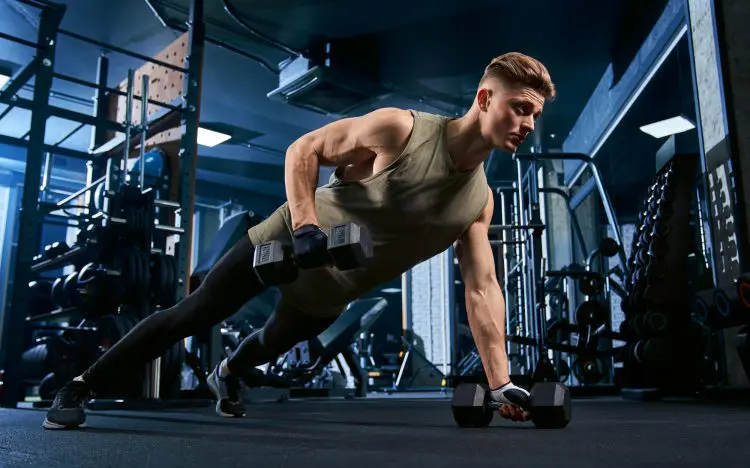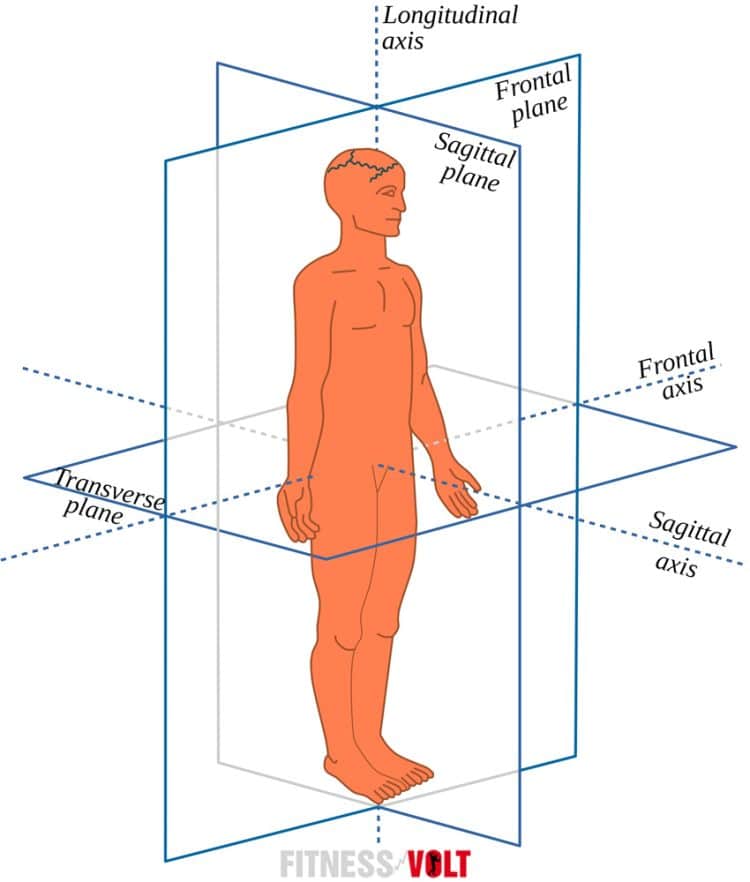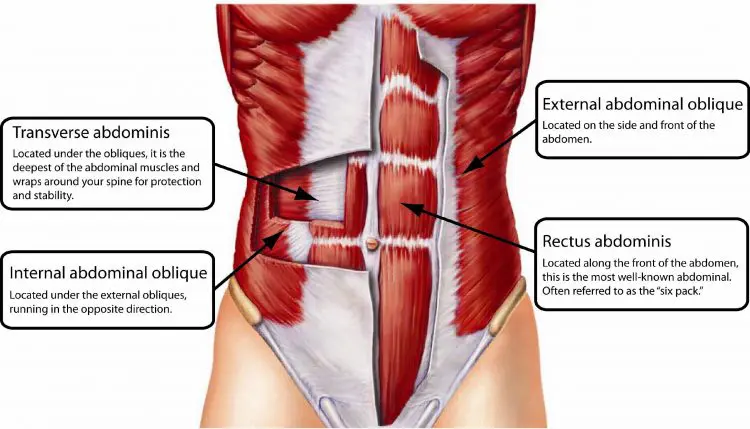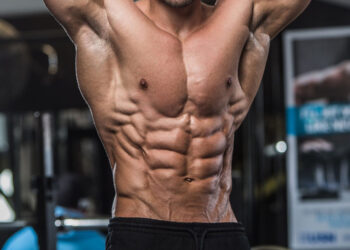When it comes to abs training, many exercisers focus too much on the anterior or front abdominal muscles. They pump out set after set of sit-ups, crunches, planks, and leg lifts to sculpt the perfect six-pack. Unfortunately, such an approach is seldom effective.
There is more than one muscle in your midsection, and if you want your abs to look and function at their best, you cannot afford to overlook any of them.
As a seasoned personal trainer with over 35 years of experience, I consistently emphasize to my clients that achieving a sculpted midsection requires more than endless spinal flexion movements to build a ripped six-pack. Rotation and anti-rotation exercises should be staples in your core workouts.
In this article, I reveal the 12 core rotation exercises.
Recent Updates: On June 1, 2024, Fitness Volt’s Senior Editor, Vidur Saini (American Council on Exercise-CPT), revised the exercise list and added actionable expert tips to improve the reader experience. Level Up Your Fitness: Join our 💪 strong community in Fitness Volt Newsletter. Get daily inspiration, expert-backed workouts, nutrition tips, the latest in strength sports, and the support you need to reach your goals. Subscribe for free!
6 Best Rotational Core Exercises
Rotational exercises involve purposeful movement of your spine. As such, they will develop dynamic strength, endurance, or power. You must use an extensive range of motion with these exercises for the best results. However, do not force the movements, as doing so could result in spinal injuries.
1. Cable high-to-low woodchop
| Sets & Reps | 3 x 8-12 |
| Equipment Needed | Cable Machine |
| Target Muscles | Obliques, Rectus Abdominis, Shoulders, Lats |
The high-to-low woodchop is a very effective transverse plane rotational core exercise. While I can’t guarantee it’ll give you chiseled obliques, it will undoubtedly increase oblique strength, power, and endurance.
“Focus on leading the movement with your elbows rather than your hands,” says Saini. It will help emphasize obliques serratus anterior muscle engagement.
Steps:
- Attach a D-handle to a high pulley machine. Stand sideways onto the weight stack and grab the handle. Then, keeping your arms straight, step away from the machine to tension the cable.
- Adopt an athletic, shoulder-width stance and brace your core.
- Turning your arms and shoulders together, rotate your upper body through 180 degrees, bringing your hands down to around hip height.
- Return to the starting position and repeat.
- Do the same number of reps on both sides.
Coach Tips:
- Shift your weight from one foot to the other as you turn your upper body.
- You can also do this exercise explosively to increase muscle power, i.e., raise the weight quickly and then lower it under control.
Benefits:
- Integrates your core with your upper and lower body.
- Good for increasing midsection mobility and flexibility.
- A very functional exercise that can boost athletic performance.
| Difficulty | Moderate |
| Progression | Use heavier weights |
| Regression | Shorten the range of motion (ROM) |
2. Cable standing Russian twist
| Sets & Reps | 3 x 10-15 |
| Equipment Needed | Cable Machine |
| Target Muscles | Obliques, Rectus Abdominis, Erector Spinae |
This exercise is similar to cable woodchops, but the weight moves horizontally rather than diagonally. Cable Russian twists are much more effective than the bodyweight or dumbbell version, as there is much more resistance to overcome.
Saini recommends exhaling sharply during the concentric phase to engage the deeper core muscles like the transverse abdominis, which aids stability and power generation.
Steps:
- Attach a D-shaped handle to a high pulley machine. Pin the pulley at mid-chest height.
- Stand sideways onto the weight stack and grab the handle. Then, keeping your arms straight, step away from the machine to engage the weights
- Adopt an athletic, shoulder-width stance and brace your core.
- Turning your arms and shoulders together, rotate your upper body through 180 degrees. Keep your arms parallel to the floor.
- Return to the starting position and repeat.
- Do the same number of reps on both sides.
Coach Tips:
- You can also do this exercise with a resistance band anchored at mid-chest height.
- Do this exercise in a half-kneeling position to take your legs out of the movement and focus more on your core.
- Keep your hands in line with the center of your chest throughout.
Benefits:
- A little easier to learn and master than cable woodchops.
- An effective exercise for integrating the core with the upper and lower body.
- A very functional and effective total core exercise.
| Difficulty | Beginner-Intermediate |
| Progression | Use a medicine ball or perform standing Russian twists with one leg lifted |
| Regression | Seated Russian twists |
3. Landmine full-contact twist
| Sets & Reps | 3 x 8-12 each side |
| Equipment Needed | Landmine Attachment, Barbell |
| Target Muscles | Obliques, Rectus Abdominis, Shoulders |
The landmine attachment is a very functional training tool that you can use to work virtually every muscle group. Most landmine exercises are unilateral, so they are good for developing general balance, coordination, and stability. Full-contact twists are a particularly effective rotational core exercise.
Initiate the twist from your core, not your shoulders, cues Saini.
Steps:
- Load the free end of the barbell and stand at its end with your feet about shoulder-width apart, knees slightly bent. Grip the bar in both hands and raise your arms above your head.
- Brace your abs and push your weight forward into the bar.
- Maintaining this forward pressure, rotate your upper body and lower your arms down to the left, shifting your weight onto your left leg as you do.
- Next, raise your arms back to the center and then lower them to the right. Again, shift your weight onto your right leg.
- Continue alternating sides for the required number of reps.
Coach Tips:
- You can also do this exercise with a regular barbell wedged into a corner or against the bottom of a squat rack.
- This exercise works well with medium to heavy weights and low to moderate reps.
- Lean forward on the balls of your feet to maximize core engagement.
Benefits:
- Keeps your core muscles under constant tension.
- Teaches you how to integrate your core with your arms and legs.
| Difficulty | Intermediate |
| Progression | Increase the range of motion |
| Regression | Perform while kneeling |
4. Lunge with rotation
| Sets & Reps | 3 x 10-12 each leg |
| Equipment Needed | Bodyweight (Optional: Dumbbells or Medicine Ball) |
| Target Muscles | Quadriceps, Glutes, Hamstrings, Obliques |
Lunges are a classic leg exercise, but they become a very effective rotational core movement when you add a twist. Use a dumbbell, medicine ball, kettlebell, weight plate, or sandbag for this exercise.
Saini recommends externally rotating your rear foot as you lunge for better hip and glute engagement and improved stability.
Steps:
- Stand with your feet together and a weight in your hands held close to your chest. Brace your abs and pull your shoulders down and back.
- Take a large step forward, bend your legs, and lower your rear knee down to within an inch of the floor.
- Simultaneously rotate your upper body toward your leading leg. Turn as far as your mobility allows.
- Push off your front leg and return to the starting position, untwisting your torso as you stand up.
- Repeat on the opposite side.
- Alternate sides for the required number of reps.
Coach Tips:
- You can do backward or walking rotational lunges for variation.
- Extend your arms in front of you to lengthen the lever and make this exercise more challenging.
- Raise your arms above your head between reps to make this exercise more dynamic and demanding.
Benefits:
- A full-body exercise that burns lots of calories as you strengthen your core and legs.
- A great way to make lunges more demanding.
- An effective way to combine core training with training your legs and arms.
- An excellent exercise for all athletes, especially racquet sports players, e.g., tennis, squash, etc.
| Difficulty | Beginner |
| Progression | Perform walking lunges or increase the speed of rotation |
| Regression | Split squats or use a chair or wall for support |
5. Windshield wipers
| Sets & Reps | 3 x 10-15 |
| Equipment Needed | NA |
| Target Muscles | Obliques, Rectus Abdominis |
Most bodyweight core rotation exercises are too easy for intermediates and advanced lifters. That’s because they offer very little resistance. Windshield wipers involve using your core to lift and lower your legs, which makes them far more challenging and ideal for stronger exercisers.
“Actively press your lower back into the floor throughout the movement to limit lower back strain,” says Saini.
Steps:
- Lie on your back with your arms extended out to the side and resting on the floor. Brace your abs and lift your legs, so they are vertical and perpendicular to the floor.
- Keeping your arms and shoulders on the floor, lower your legs down to the floor, so your feet touch down near your hands.
- Raise your legs back to the center and then lower them to the opposite side.
- Continue for the desired number of reps.
Coach Tips:
- Bend your legs to shorten the lever and make this exercise less demanding.
- Adjust your range of motion to reflect your mobility and flexibility. You don’t have to lower your feet all the way down to the floor for this exercise to be effective.
Benefits:
- A challenging move that’s ideal for intermediate and advanced exercisers.
- A bodyweight-only exercise that’s suitable for home exercisers.
- An effective mobility exercise for the lower back.
| Difficulty | Advanced |
| Progression | Add ankle weights |
| Regression | Hanging knee raises |
6. Stability ball core rotation
| Sets & Reps | 3 x 15-20 |
| Equipment Needed | Stability Ball |
| Target Muscles | Obliques, Rectus Abdominis, Shoulders |
While most people are familiar with stability ball crunches, far fewer use a stability ball for rotational training. Stability ball core rotations work your abs and obliques and involve your legs and lower back. This makes them a great way to integrate your core with your lower body.
Saini suggests pushing your hips forward as you rotate to keep your spine neutral. It also boosts core engagement and prevents excessive spinal flexion.
Steps:
- Sit on your stability ball, feet a little wider than shoulder-width apart.
- Walk forward and lean back until your weight is resting on your feet and shoulders only.
- Brace your abs and extend your hips, so your body is straight and level with the floor. Extend your arms and clasp your hands together.
- Keeping your arms straight and your hips relatively level, rotate your upper body and roll onto one shoulder.
- Return to the center and then roll to the other side.
- Continue alternating sides for the required number of reps.
Coach Tips:
- Rotate your upper body as far as your mobility allows — do not force it!
- Use a narrower stance to make this exercise more challenging.
Benefits:
- An excellent move for home exercisers.
- Good for developing mobility and core strength.
- Teaches you how to use your legs and core together.
| Difficulty | Beginner |
| Progression | Perform on an unstable surface (BOSU ball) |
| Regression | Seated twists on a bench or chair |
6 Best Anti-Rotational Exercises
Anti-rotation exercises teach you to maintain core stability while moving your arms or legs. Keep your core braced during these exercises to ensure your torso remains rigid and unmoving.
1. Pallof press
| Sets & Reps | 3 x 10-15 each side |
| Equipment Needed | Cable Machine or Resistance Band |
| Target Muscles | Obliques, Rectus Abdominis, Transverse Abdominis |
The Pallof press was invented by American physical therapist John Pallof. It’s since become one of the most widely performed anti-rotation core exercises. The reason for this is simple: it really does work!
“Maintain a proud chest throughout the exercise,” urges Saini. It activates your thoracic spine extensors and helps you resist the rotational force from the cable or band.
Steps:
- Attach a D-shaped handle to a cable machine set to around mid-chest height.
- Stand sideways-on to the pulley and hold the handle with both hands. Your feet should be roughly shoulder-width apart, knees slightly bent. Brace your core.
- Pull your hands into your chest and step away from the machine to tension the cable.
- Keeping your hips and shoulders stationary, extend your arms out in front of you. Notice how you have to use your core to stop your upper body from twisting.
- Bend your arms and pull your hands back into your chest.
- Repeat for the required number of reps.
Coach Tips:
- You can also do this exercise with a resistance band.
- Vary the angle of your arms to provide your core with a different challenge.
Benefits:
- A very spine-friendly core exercise.
- Very scalable — adjust the weight to reflect your current core strength.
- A straightforward exercise that’s ideal for beginners.
| Difficulty | Beginner-Intermediate |
| Progression | Step further away from the anchor point |
| Regression | Use a lighter band |
2. Single-leg Romanian deadlift
| Sets & Reps | 3 x 8-12 each leg |
| Equipment Needed | Dumbbell (Optional) |
| Target Muscles | Glutes, Hamstrings, Core |
Romanian deadlifts are one of the best posterior chain exercises you can do. However, switching from two legs to one quickly makes it an equally effective anti-rotation core exercise. As an added benefit, this is also a great way to improve balance.
Saini prescribes keeping the non-working leg slightly bent to prevent knee hyperextension, maintain proper alignment and reduces stress on the joint.
Steps:
- Stand with your feet together and a dumbbell or kettlebell in your left hand. Shift your weight over onto your right foot and brace your core.
- Hinge forward from your hips and lower the weight down toward the floor. Extend your left leg out behind you as a counterbalance.
- Stand back up and repeat.
- Rest a moment and then do the same number of reps on the opposite leg, remembering to hold the weight in the other hand, too.
Coach Tips:
- Rest your non-working foot lightly on the floor for balance if needed, i.e., B-stance or kickstand single-leg Romanian deadlifts.
- Try holding the weight in the same hand rather than the opposite hand. This is considerably more challenging.
Benefits:
- A time-efficient way to train your core and legs at the same time.
- An excellent exercise for improving balance and coordination.
- More lower back-friendly than two-legged Romanian deadlifts.
| Difficulty | Intermediate |
| Progression | Perform on an unstable surface (BOSU ball) or slow down the eccentric phase |
| Regression | Bodyweight RDLs or use a wall for support |
3. Renegade row
| Sets & Reps | 3 x 8-10 each arm |
| Equipment Needed | Dumbbells |
| Target Muscles | Lats, Shoulders, Triceps, Core |
The renegade row is a challenging anti-rotational core exercise that also builds upper back strength. It’s a popular exercise with athletes and works well in circuit and HIIT workouts. Go light — this exercise is more strenuous than it looks!
Saini recommends squeezing the glutes to stabilize your core during this exercise.
Steps:
- Hold a dumbbell in each hand, squat down, and place them on the floor. Walk your feet out and back into the push-up position. Brace your core and tense your legs.
- Next, bend one arm and row your dumbbell up and into your lower ribs. Lead with your elbow and keep your hips and shoulders level.
- Lower the weight back to the floor, switch arms and repeat.
Alternate arms for the required number of reps.

Coach Tips:
- Wear a weighted vest to make this exercise even harder.
- Use hexagonal dumbbells, as they’re less likely to roll away.
- Combine this move with push-ups for a total upper-body and core workout like this:
Benefits:
- Teaches you to brace your core as you exercise your arms and legs.
- A very time-efficient exercise that burns a lot of calories.
- A challenging movement that’s ideal for intermediate and advanced exercisers.
| Difficulty | Intermediate-Advanced |
| Progression | Elevate feet or perform push-ups between rows |
| Regression | Perform on knees |
4. Single-arm cable chest press
| Sets & Reps | 3 x 8-12 each arm |
| Equipment Needed | Cable Machine |
| Target Muscles | Chest, Shoulders, Triceps, Obliques, Rectus Abdominis |
The single-arm chest press is an excellent anti-rotation core exercise! To integrate your core with your upper and lower body, do this move with light to moderate weights and for medium to high reps.
Remember, you must keep your core steady throughout the exercise to reap the anti-rotational benefits.
Steps:
- Attach a D-handle to a chest-high cable machine pulley.
- Hold the handle and turn your back on the machine, so the cable runs outside your arm. Adopt a split stance for balance. Brace your core.
- Keeping your hips and shoulders stationary, push your arm forward and out to full extension.
- Bend your arm, bring the handle back to your chest, and repeat.
- Switch sides and do the same number of reps with the other arm.
Coach Tips:
- Try pressing up at an incline to change the feel of this exercise.
- Do this exercise with your feet together to increase the core and balance demand.
- You can also do this exercise with a resistance band, or in a half-kneeling position, like this:
Benefits:
- Infinitely scalable by increasing or reducing the weight.
- Suitable for beginner, intermediate, and advanced lifters.
- A very spine-friendly anti-rotation core exercise.
| Difficulty | Beginner-Intermediate |
| Progression | Add a pause at the bottom of the movement |
| Regression | Use a resistance band |
5. Bird-dog
| Sets & Reps | 3 x 10-12 each side |
| Equipment Needed | Bodyweight |
| Target Muscles | Core, Glutes, Shoulders, Back |
The bird-dog is so-called because, when you do it, you look a little like a hunting hound pointing. Odd names aside, this is an excellent anti-rotation exercise you can do anywhere and anytime. It’s perfect for beginners and for warm-ups when you want to wake up your core muscles.
“Imagine your limbs are being pulled away from your body by strings,” cues Saini. It will help maintain tension throughout the movement.
Steps:
- Kneel on all fours so your hips are directly over your knees and your shoulders are over your hands. Brace your core and tuck your chin in to lengthen your neck.
- Lift and extend your left arm and right leg until they are parallel to the floor. Keep your shoulders and hips level.
- Lower your arm and leg and touch your hand to your knee.
- Repeat for the desired number of reps and then swap sides.
Coach Tips:
- Kneel on a folded exercise mat for comfort.
- Use ankle/wrist weights to make this exercise more challenging.
- You can also do this exercise in a high plank position like this:
Benefits:
- No equipment is required, so you can do this exercise anywhere and anytime, even at home.
- An ideal exercise for beginners.
- An excellent exercise for people with low back pain.
| Difficulty | Beginner |
| Progression | Perform on an unstable surface |
| Regression | Perform only the arm or leg extension at a time |
6. Single-arm plank
| Sets & Reps | 3 x 30-60 seconds each arm |
| Equipment Needed | Bodyweight |
| Target Muscles | Core, Shoulders, Back |
Most people know that planks are great abs exercise. However, as effective as they are, planks mostly work your anterior core and do very little for your obliques. That all changes when you do single-arm planks. They’re also much more challenging than the regular version.
Saini urges actively pushing your working forearm into the floor during the exercise to maximize ab and oblique stimulation.
Steps:
- Adopt the regular plank position with your weight resting on your forearms and feet. Your body should be perfectly straight, and your core braced.
- Shift your weight onto one arm and place your other arm down by your side so you are balancing on three points of support.
- Keep your hips and shoulders level, and don’t lift or lower your butt.
- Hold this position for the required duration.
Coach Tips:
- Bend your legs and rest on your knees to make this exercise easier for beginners.
- Move your feet closer together to make this exercise harder or further apart to make it easier.
- You can also do this exercise in a high plank position, i.e., with straight arms.
Benefits:
- No equipment is required, so you can do this exercise anywhere and anytime.
- A great way to make planks more challenging and save you from having to hold them for several minutes at a time.
- A challenging total core exercise that involves simultaneous anti-rotation and anti-flexion.
| Difficulty | Intermediate |
| Progression | Lift one leg, perform on an unstable surface, or add a weight plate to the back |
| Regression | Conventional plank |
Best Rotation and Anti-Rotation Exercise Workout for Functional Core Strength
Do this workout two to three times weekly for the best results:
| Exercise Name | Sets | Reps | Rest Time |
| Cable High-to-Low Woodchop | 2 | 8-12/side | 60 seconds |
| Landmine Full-Contact Twist | 2 | 8-12/side | 60 seconds |
| Stability Ball Core Rotation | 2 | 15-20 | 30 seconds |
| Pallof Press | 2 | 10-15/side | 60 seconds |
| Renegade Row (with controlled hips) | 2 | 8-10/side | 60 seconds |
| Bird-Dog | 2 | 10-12/side | 30 seconds |
| Single-Arm Plank | 2 | 30-60 seconds/side | 30 seconds |
| Dead Bug (optional) | 2 | 10-12 | 30 seconds |
The Three Planes of Motion
The human body consists of 206 bones and over 600 muscles, making it capable of hundreds of different movements. And yet, when it comes to exercise, many people tend to only move in two directions — forward and backward.
There are actually several more types of movement, which are classified into three anatomical planes.
The three planes are:
Level Up Your Fitness: Join our 💪 strong community in Fitness Volt Newsletter. Get daily inspiration, expert-backed workouts, nutrition tips, the latest in strength sports, and the support you need to reach your goals. Subscribe for free!
The sagittal plane
This is the plane that most people tend to overemphasize in training. The sagittal plane divides the left side of your body from the right, and sagittal plane movements are either forward (pushing) exercises or backward (pulling) exercises.
While sagittal plane exercises can be good for building general strength and muscle size, they are often not as functional as they could be. For example, apart from rowing and 100-meter sprinting, most sports don’t involve traveling in a perfectly straight line. The same is true for many everyday activities.
So, while there is nothing inherently wrong with sagittal plane exercises, if you want to develop multidirectional fitness and strength, you need to train in the other planes, too.
The frontal plane
The frontal plane divides the front of your body from the back, and movements in the frontal plane involve going sideways. Examples include lateral raises with dumbbells, hip abductions and adductions, side bends, and side planks. Transverse plane movements are also common in many sports, e.g., side-stepping around an opponent in soccer or basketball.
The transverse plane
Dividing your body horizontally, transverse plane movements are rotational in nature. The transverse plane is highly underutilized in training but is actually one of the most critical and common movement planes outside of the gym.
A huge number of activities involve the transverse plane, including running, throwing, kicking, punching and lifting. Even walking involves movements in the transverse plane.
In some cases, the movements are very large and dynamic, such as winding up to throw a baseball. In other instances, the movements are much smaller and may even be non-existent, e.g., when bracing your core as you walk or run to prevent unwanted twisting.
Most abs workouts focus on the sagittal plane and neglect the frontal and transverse planes. This can affect muscular development and core performance. While there is nothing wrong with crunches (sagittal plane) and side bends (frontal pane), most people would benefit from more rotational (transverse plane) exercises in their core workouts.
Functional Core Anatomy
When most people think about abs training, they don’t get much further than the muscle on the front of their stomach — the rectus abdominis. This makes a certain amount of sense, given that the rectus abdominis is your six-pack muscle.
However, your midsection is actually made up of several muscles, all of which are just as important as your abs. Collectively, these muscles are called your core. The core is essentially a cylinder with a top, bottom, front, and back.
While some people include almost every torso muscle as part of the core, the ones we are most interested in are:
Rectus abdominis
While this is the most overused and overemphasized core muscle, the rectus abdominis still important. Located on the front of your abdomen, the rectus abdominis is a long, flat muscle segmented by lines of ligamentous tissue, giving it that famous six-pack appearance.
The functions of the rectus abdominis are flexion and lateral flexion of the spine and compression of the abdominal contents.
Obliques
Located to the side of the rectus abdominis, the obliques are basically your waist muscles. There are two sets of obliques — internal and external — which work together to rotate and laterally flex your spine. The obliques are the most dominant muscle group during rotation and anti-rotation training.
Erector spinae and multifidus
The erector spinae is the collective name for the three muscles of your lower back — iliocostalis, longissimus, and spinalis. The main function of the erector spinae is the extension of your spine. Still, working with the rectus abdominis and obliques, they also play a role in lateral flexion.
Multifidus is another lower back muscle. It works with the erector spinae to extend your spine and forms the back of your abdominal cylinder.
Transverse abdominis
Known as the TVA for short, this muscle encircles your abdomen like a corset or weightlifting belt. When the TVA contracts, it pulls inward and increases intra-abdominal pressure. This pressure helps support and stabilize your spine from within.
Bracing your abs, which is a common instruction during most strength training exercises, increases IAP and helps keep your spine rigid and protected from injury.
Diaphragm
The diaphragm is your primary breathing muscle. Located at the top of your abdominal cavity, it works with your TVA to increase intra-abdominal pressure. Think of the diaphragm as the lid of your abdominal cylinder. Timing your breath to your workout ensures that IAP peaks when you need it the most, i.e., inhaling as you lift a heavy weight and exhaling as you lower it.
Pelvic floor
If the diaphragm is the lid of your abdominal cylinder, the pelvic floor is the bottom. Like the diaphragm, it contracts inward and contributes to IAP.
So, as you can see, there is more to core training than doing sit-ups and other anterior abdominal exercises. Your core is a multi-dimensional muscle group, and if you want to fully develop it, you need to do exercises in all three planes. However, in this article, we’re mainly interested in the transverse plane as it’s usually the most underutilized.
Rotation vs. Anti-Rotation – What’s the Difference?
So, now you know which muscles make up your core and the value of training in the transverse plane by performing rotational core exercises. But what’s the difference between rotation and anti-rotation?
That’s a good question!
Simply put, rotational exercises involve purposeful movement of your spine, typically some form of twisting. In contrast, anti-rotation exercises involve preventing unwanted movement.
Generally speaking, rotational movements involve an eccentric and a concentric contraction of the target muscles. Conversely, anti-rotation exercises are isometric or static. That means your muscles generate force but do not shorten or lengthen.
Ideally, a balanced core workout should include rotation and anti-rotation exercises, as both functions are essential for optimal strength and performance.
FAQs
1. Do I need to do core rotation exercises for my abs?
In the same way that you should train your biceps AND triceps and your quads AND hamstrings, you should include rotational exercises in your abs workouts. Not doing them means your obliques will go largely untrained, which could affect the function and appearance of your midsection.
Adding rotation exercises to your abs workouts will ensure that all your core muscles are developed equally, eliminating any potential weaknesses.
2. Can’t I just do twisting crunches for my obliques?
Most basic abs exercises can be done with a twist to increase oblique engagement. However, there is very little resistance to rotation, which means that while the obliques are working, they aren’t under much tension.
If you want to strengthen and develop your obliques, you must overload them by providing resistance to rotation. Twisting crunches, sit-ups, etc., are not an effective way to work your obliques.
3. How many times per week should I do core rotation exercises?
Like most muscle groups, your core muscles respond best to 2-3 workouts per week. However, it’s worth remembering that these muscles are also involved in most upper and lower body exercises, so they may not need so many workouts.
Start by doing core rotation exercises once per week, and add another workout if you feel your core needs more attention.
4. How many reps should I do?
A lot of exercisers mistakenly believe that doing high-rep abs exercises will burn fat and leave them with a slender stomach. This is not true! Doing very high reps is largely a waste of time, and it is impossible to spot reduce fat from your abs or any other part of your body.
So, for time efficiency, choose exercises that fatigue your abs in 8-30 reps. If you can do more than 30 reps, your chosen exercise is probably too easy to be effective.
Related: Best Weighted Abs Exercises and Workouts
Wrapping Up
Whether you want six-pack abs or improve core strength and stability, you need to include rotation and anti-rotation exercises in your midsection workouts. Rotation exercises target your oblique or waist muscles, which will be underdeveloped unless you train them directly.
While doing core rotation exercises won’t melt fat from your midsection, they won’t make your waist thicker, either. However, training your obliques will give you a tighter, more muscular waist and could even reduce your risk of developing lower back pain.
So, don’t just train your anterior core muscles. Make sure you work your obliques, too. Rotation and anti-rotation exercises are the best way to do it!










